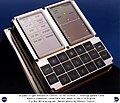ملف:Apollo display and keyboard unit (DSKY) used on F-8 DFBW DVIDS683588.jpg

حجم هذه المعاينة: 765 × 600 بكسل. الأبعاد الأخرى: 306 × 240 بكسل | 612 × 480 بكسل | 980 × 768 بكسل | 1٬280 × 1٬004 بكسل | 2٬560 × 2٬007 بكسل | 3٬030 × 2٬376 بكسل.
الملف الأصلي (3٬030 × 2٬376 بكسل حجم الملف: 6٫18 ميجابايت، نوع MIME: image/jpeg)
تاريخ الملف
اضغط على زمن/تاريخ لرؤية الملف كما بدا في هذا الزمن.
| زمن/تاريخ | صورة مصغرة | الأبعاد | مستخدم | تعليق | |
|---|---|---|---|---|---|
| حالي | 06:29، 9 أكتوبر 2021 |  | 3٬030 × 2٬376 (6٫18 ميجابايت) | Huntster | Cropped 9 % vertically using CropTool with lossless mode. |
| 06:28، 9 أكتوبر 2021 |  | 3٬030 × 2٬606 (5٫97 ميجابايت) | Huntster | Full resolution from NASA. | |
| 00:42، 6 مايو 2015 |  | 1٬536 × 1٬321 (303 كيلوبايت) | Fæ | == {{int:filedesc}} == {{milim | description = {{en|1=The display and keyboard (DSKY) unit used on the F-8 Digital Fly-By-Wire (DFBW) aircraft during Phase I of the fly-by-wire program. Warning lights are in the upper left section, displays in the uppe... |
استخدام الملف
الصفحة التالية تستخدم هذا الملف:
الاستخدام العالمي للملف
الويكيات الأخرى التالية تستخدم هذا الملف:
- الاستخدام في en.wikipedia.org
- الاستخدام في es.wikipedia.org
- الاستخدام في fi.wikipedia.org
- الاستخدام في fr.wikipedia.org
- الاستخدام في he.wikipedia.org
- الاستخدام في hu.wikipedia.org
- الاستخدام في ja.wikipedia.org
- الاستخدام في pl.wikipedia.org
- الاستخدام في ru.wikipedia.org
- الاستخدام في uk.wikipedia.org

